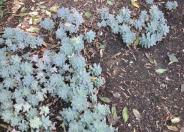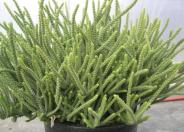
Common name:Ghost Plant
Botanical name:Graptopetalum paraguayense
Ghost plant is an unusually colored small succulent from Mexico with 3 to 6 inch wide rosettes. The range of color is part of the great charm of this plant. The color ranges from pale blue, light pink, to light purple. The plant multiplies rapidly and is easy to propogate. In spring, it has white flowers that have small red touches. It does well in full sun to light shade and prefers well-drained soil. Irrigate infrequently to occasionally although it does not like wet feet so good drainage is critical if watering regularly.

Common name:Watch Chain
Botanical name:Crassula muscosa
Crassula muscosa is best known to be a beautiful looking succulent. As the plant matures you can expect it to reach up to 10" tall. The plant is best known for the leaves that are small and desnely packed together growing erect in the color green to bright green. When the plant finally produces flowers you can expect yellow flowers in the spring. Crassula muscosa can be quite beautiful when it is well-taken care of. This succulent type needs typical watering as the other succulents. The watering method is very important to keep your plant healthy. It should not sit on the water, and an excess amount of water should be avoided. The best way of watering is soak and dry method this succulent. Yet, the succulent should be controlled to avoid overwatering. Crassula muscosa needs strong light. When planting this succulent type in a garden, make sure it gets sunlight. Full to partial sun is the best for its growth. It is better to grow outdoor rather than indoor. This type of succulent prefers a warm climate. It can survive at zone 9a-11b which is around 20°F. If you live in a cold area, it is better to plant in an indoor environment. As long as it gets enough sunlight, the plant will grow happily.

Common name:Burgundy Jade
Botanical name:Crassula platyphylla ‘Burgundy’
The Crassula Platyphylla’ Burgundy’ is a slow-growing plant that only reaches about six inches in height. The plant doesn’t develop an extensive root system, and it typically grows in dense clusters. It is a succulent plant with thick, fleshy leaves; native to South Africa, it is the only variety of the species that has burgundy-colored leaves. Cool weather intensifies the color. Crassula platyphylla will thrive in a position that is exposed to plenty of sun, but it does not tolerate full-sun exposure. Instead, this type of plant prefers partial shade. The sun should not shine directly on the leaves for more than six hours per day, which is why this type of succulent prefers partial shade. This plant needs to be watered at least once per week, and the soil should not be allowed to dry out. Rainwater is preferred over tap water because it does not contain any chlorine or fluoride that could damage your plants. Crassula platyphylla succulents need a very well-draining mix in their pots so that they don’t rot from too much water staying on them for extended periods. But before planting your plant, make sure to add some compost as this will increase drainage even more! This houseplant does best in humid conditions around 60% relative humidity. The best place to grow these plants is indoors and in a pot with drainage holes and porous dry soil with enough organic material for the plant to thrive on. You should prune any time the Crassula begins growing larger than desired or starts getting too leggy and “stringy.”
Designer:
Photographer: Vicki Anderson
Practice grass-cycling by leaving short grass clippings on lawns after mowing, so that nutrients and organic matter are returned to the soil.
Attract, or buy beneficial insects such as ladybugs and lacewings to control pest outbreaks in your garden.